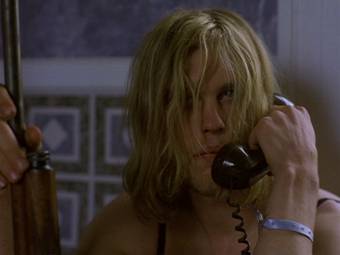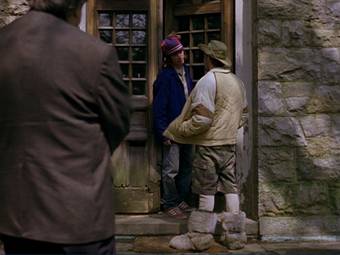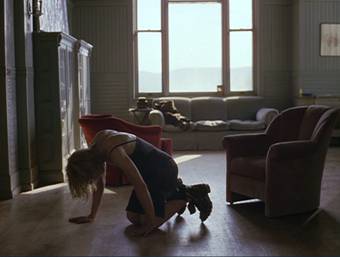| "Every
living creature on this earth dies alone." |
| Grandma
Death – Donnie Darko |
The
annals of rock are peppered with tales of fast lives and
young deaths, whether it be by accident (Marc Bolan – car
crash) or drug abuse (do I really need to make a list here?)
or, in the case of Nirvana's iconic lead singer Kurt Cobain,
by shotgun-assisted suicide. We are left with a sense of
waste, of what might have been were it not for the intervention of fate,
but also a feeling that in a world in which those who are
at an age when experimentation is the norm suddenly have
access to anything they want, there is a sad inevitability
to such stories. The principle concern of Last Days,
which follows a wasted rock star as he gradually implodes
within the confines of his decaying mansion estate, is not
the how and why of what happens, but to connect us
with the experience of the person it is happening to. Whether
it succeeds in doing so has been a matter of some very passionate
debate.
The
first thing to note is that this is not a biographical film.
The poster suggests it is about Kurt Cobain, a lot people
think it is about Kurt Cobain, and director Gus Van Sant
has freely admited that it was inspired by Cobain's untimely passing
(he even says so on the closing credits), but that's as
far as it goes in terms of historical fact. This is a supposition,
a reality-suggested fiction, and charges of technical inaccuracy
have no place here. It's not this that has caused most of
the disagreement, of course, but Van Sant's narrative and
cinematic minimalism, rejecting traditional storytelling
in favour of creating a sense of the location and the mindset
of his main character, an approach first explored in his
previous 'wasted youth' films, Gerry (2002)
and Elephant (2003). If you've seen either
of these then you'll at least have an idea what you're in
for, if not then you may be unprepared for what you get.

As
with Elephant, dialogue is initially of
little importance and effectively absent for the first twenty
minutes, as Blake, the musician around which the film is
centred, stumbles through the countryside surrounding his
house, walking with undisclosed purpose up paths and driveways
mumbling almost incoherently to himself. This aspect may
well prove unintentionally comical to hardened Monty Python
fans, sounding as it does somewhat similar to the grumblings
of the caterpillar man who blossoms into a butterfly in
one of Terry Gilliam's more memorable animations. But it
is both appropriate and authentic, and as the film progresses
it becomes as much part of the soundtrack as the clock chimes,
splashing water and motorised whines that drift into the
background. Inappropriate to the location, they act like
fragments of trace memories, something good or bad from
Blake's past that he cannot shake off, that continue to haunt him even in his
permanently bombed-out state.
The
camera unhurriedly follows Blake as he carries out the most
mundane of tasks, or rather as he attempts to, pouring milk
onto his cereal and then placing the cereal box in the
fridge and ignoring the breakfast, his focus gone and his
memory span down to that of a goldfish. His vastly decreased
ability to verbally communicate has him listen silently
to an agitated phone call from what sounds like his manager,
sit bemused with a Yellow Pages salesman who gives him a
cheery sales pitch in spite of his client's black negligee and dazed demeanour, and almost comically flee the arrival
of music industry player Donovan and a talkative private
investigator. A small number of what we presume are band
members and their girlfriends are also staying at the mansion,
but their contact with Blake is fleeting, showing passing
concern when he loses consciousness, complaining about the
heating, and requesting help from him with their songwriting.
They all talk to him but are essentially unconcerned with
his state of mind and body, wrapped up as they are in their
own immediate needs and shallow enjoyment. We learn from
grabbed conversations that Blake has recently spent time
in drug rehabilitation, very recently if the plastic strap
on his wrist is what it appears to be. It clearly didn't
work and Blake has once again fallen, but his companions
have seen it all before – Blake is wasted, Blake is uncommunicative,
but that's how Blake is. No-one tries to actually connect
with him any more. At the height of his fame, at the peak
of his talent, Blake is utterly and completely alone.
There
is no suspense regarding Blake's inevitable demise, but this
is clearly deliberate – you don't link your film to the
suicide of Kurt Cobain and call it Last Days
if you are intending to surprise the audience with an eventual
suicide, a point nailed home by Van Sant's decision not to show the
act itself. Which brings us back to the film's real focus
and its attempt to connect us with Blake's state
of mind and his sense of dislocation from the world around
him. Whether it succeeds in doing so is certainly a subjective
judgment (but then what film isn't?), and a friend who was
at our cinema screening was left in no doubt that the connection
was not made, echoing the review in Sight & Sound
that suggested the film was visually compelling but emotionally
hollow. I beg to differ. I will freely admit that we never
get to connect with Blake as a person or to understand
any of the pressures or temptations that drove him to this condition, but the sense of a life in
complete emotional and intellectual self-destruction is
sometimes overpowering. As played by Michael Pitt, Blake's
body language effectively defines his character, as he walks
to his house, fools around comically (but by association
ominously) with a shotgun, slips in and out of consciousness,
and writes final words in a journal that provide the only
hint at his feelings and motivation. In one extraordinary
sequence, as we watch him crumble slowly to the ground under
the weight of drugs we never see him take, the soundtrack
seems to well up and swallow him, a near-perfect marriage
of image and sound that is as vivid a cinematic realisation
of drug burn-out as I've ever seen, and done in one static
shot without a hint of visual tomfoolery.

Such
moments appear throughout the film, unfussily shot sequences
in which picture and sound combine to arresting effect,
such as when band member Scott sits half-wasted and sings
along to Venus in Furs by The Velvet Underground,
lost in the moment and switched off from those around him.
It's a strangely spellbinding moment, though perhaps, once
again, a subjective one – watching Scott I felt I was watching
myself, as someone who has in his time been out of his head
and screamed along to his share of rock songs, this one
included. I was left in little doubt that Van Sant (and
maybe actor Scott Patrick Green) has done likewise, and this is precisely
how the film bonds us with Blake, through the sense of
a shared experience, how it FEELS to be lonely, wasted,
disconnected, suicidal, lost. Far from distancing us from
him, Van Sant's technique connects us sometimes electrifyingly
to his state of mind, albeit in an semi-abstract manner.
This
is most vividly realised in two scenes centred around Blake
and his music, which has become his only effective method
of communication – as the rest falls apart, it's the one
part of Blake that remains intact, whole, and vibrant. The first
is a slow, hypnotic track back from the window of a music
room in which Blake moves from one instrument to another,
playing each in turn as the soundtrack retains and repeats
each one, building an initially melodic but ultimately chaotic
symphony of his mental and emotional disarray. The other,
also a wide shot, is a second take on an already viewed
scene (a technique repeated, and slightly diluted, from
Elephant) in which what on the first run
appeared to be background music is revealed to be Blake
playing one of his own songs. As the band members drift
off to bed and sex, this second, alternate view of the scene
stays with Blake as he belts out the tune with an urgency
and passion that powerfully conveys the talent that still
lives inside the crumbled remains of the man, and in a language
he is still able to speak with considerable eloquence. Crucially,
on both occasions he is alone, the others having become
wrapped up in their own meaningless desires. When Blake
is finally able to communicate, no-one is there to listen.
Framed
4:3, this is not a cropped print but very close to the original
1.37:1 aspect ratio. It should be noted that the region
1 disc offers a choice between 4:3 and an anamorphic 1.66:1,
and that in this case the widescreen transfer is the cropped
version. The quality of the print and transfer here is first
rate, especially given that the use of natural light in
sometimes less than ideal conditions (Blake walking outside
at night). Colour, detail and contrast are all impressive
– some shots that I remember looking a little washed out
in the cinema actually look fine here.

There
are two soundtracks available, Dolby stereo 2.0 and a most
unusual Dolby 3.1, which utilises the front three speakers
and the sub and ignores the rears. Though I'd have welcomed
a fully inclusive mix, given the strength of the film's
soundtrack and its importance to the effectiveness of Van
Sant's approach, this is still a gorgeously recorded and
mixed track. Sound effects and music are reproduced with
pin-sharp clarity, and the separation is remarkably precise,
with sounds and voices placed at very specific points on
the front sound stage. A lovely job.
Here
Optimum's region 2 disc definitely has the edge on its American region
1 equivalent, with a quite reasonable selection of extras for a disc
with no special edition label.
The
Trailer (1:44) is anamorphic 16:9 and does a decent jon of promoting a film that is, frankly, not an easy
sell.
The
Making-Of Featurette (20:11)
is non-anamorphic 16:9 (a nice spread of aspect ratios and
formats on this disk) and includes some wobbly behind-the-scenes
footage, plus brief interviews with actors Michael Pitt,
Lukas Haas, Ryan Orion, Scott Green, the Friberg brothers
(who play the door-to-door God boys), producer Dany Wolf,
cinematographer Harris Savides, though not, surprisingly,
Mr. Van Sant. Engaging though not that revealing, it does
confirm the level of improvisation that took place on set,
and reveal a similarity between some of the actors and the
characters they play. It also confirms my suspicion that
Thadeus A. Thomas, who plays the Yellow Pages salesman,
is not an actor at all but – yep – a Yellow Pages salesman.
There
is one Deleted Scene (7:47), which
is more an unused shot, being a high angle interior of the
mesmerising scene in which Blake plays a variety of instruments.
Here it is very clear that Pitt is playing for real.
Music
Video (4:26) has Pitt as Blake really doing
the Kurt Cobain thing in a mocked-up music video for Happy
Song, written by Pitt and directed by Christian Zucconi.
It would have been nice to know if this is a Last
Days tie-in or something Van Sant had created with
the possible intention of using it in the film.
On
the Set: The Long Dolly Shot (8:41) is more
behind-the-scenes stuff, concentrating on the slow track
from the room in which Blake is playing the instruments.
The technical aspects of this are intriguing, with crew
members having disassemble and remove the segments of track that have already been passed over to prevent it appearing in
shot as the camera pulls back, then re-attach them to the
rear for the camera to move onto later. As you might imagine,
this was no one-take success, and does suggest they were working
on a pretty tight budget. As someone who has had to do multiple
takes because of problems working with micro-budget tracking
systems, I got quite wound up watching this. The celebration
when they finally succeed is infectious.
Other Releases, being essentially a promo
for other Optimum discs, is not normally something I'd include
here, but it does include a trailer for Elephant
(1:55), and if you've come to Last Days
without seeing either of Van Sant's 'wasted youth' films
it does point you in the right direction.
Finally
we have a Michael Pitt Interview (26:17) in which the actor talks about the genesis of the
film, his introduction to independent cinema, his music,
the Kurt Cobain aspect ("It's not a film about him,
it's a film for him"), the location, playing
Blake, and working with Van Sant. A very laid-back talker,
Pitt nonetheless provides some interesting background to
his character and approach.
Though
there is definitely a love it/hate it aspect to
Last Days, it also seems possible to sit somewhere
in the middle and admire it for its technique and yet remain
emotionally or perhaps even intellectually uninvolved. For
my own part I have become more appreciative of the film's
very considerable qualities with each viewing (four to date),
but I do have to say that this is one work whose extraordinary
hold is definitely diminished on the smaller screen. In
the cinema it fills your field of vision, you notice the
smallest things happening in the widest of shots, and your
attention is not allowed to wander for a second, something
you just can't say of home viewing, however big your TV
or ideal the conditions. But it is still a remarkable work,
and its DVD incarnation benefits from excellent picture
and sound and some interesting extra features. It's definitely
not for everyone, but this is certainly Outsider Cinema
in the best sense of the term, a minimalist experiment that
to my mind wholeheartedly achieves its aim.
|